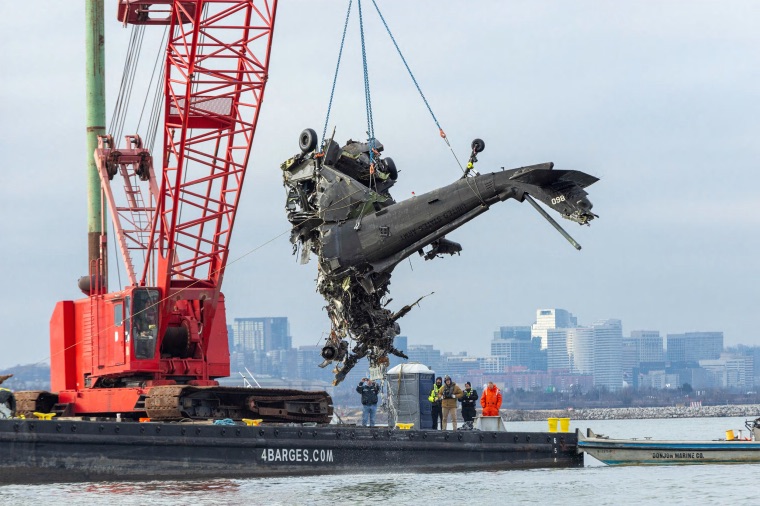As new details emerge regarding the Potomac River mid-air collision, we can now establish several key facts that point toward the real cause of this tragic accident. While the National Transportation Safety Board (NTSB) will ultimately determine the official cause, open-source information and independent investigators have provided compelling evidence that allows us to piece together the probable cause before the NTSB’s final report.
Additionally, it is now believed that there was not just a single controller in the tower that night—multiple controllers, including supervisors and supporting personnel, were present. However, not all were on the radio, which is a standard practice in air traffic control operations.
Key Takeaways:
- ATC initiated “visual separation,” reducing safety margins to near zero.
- The controller ignored multiple warning signs that a collision was imminent.
- The helicopter misidentified the CRJ and failed to pass behind it as directed.
- The crash highlights the dangers of transferring separation responsibility in busy airspace.
Get Involved: Do you believe ATC is primarily at fault, or does the helicopter crew bear equal responsibility? Could systemic FAA policies be a factor in this tragedy? Please share your thoughts in the comments below.
With this context in mind, let’s take a deeper look into what may have truly caused this disaster.
Was This a Clear Case of ATC Error?
A new analysis by aviation investigator Dan Gryder presents a strong case that this mid-air collision was the result of an Air Traffic Control (ATC) error. Gryder argues that the controller facilitated an unsafe scenario by using a specific ATC provision known as “Visual Separation.”
The ATC’s Responsibility: Preventing Collisions
According to the FAA’s ATC manual (7110.65AA), the primary purpose of the Air Traffic Control system is to prevent collisions and ensure separation between aircraft. This separation can be maintained in three ways:
- Vertical Separation – Keeping aircraft at least 1,000 feet apart.
- Lateral Separation – Ensuring aircraft remain at least 3 to 5 miles apart.
- Visual Separation – A special clearance where one aircraft takes responsibility for avoiding another, reducing separation standards to near zero.
ATC must ensure that at least one of these separation standards is always maintained. However, in the case of the Potomac collision, all three failed.
The Critical ATC Communication Breakdown
The “Visual Separation” Loophole
Before the crash, the DCA Tower controller instructed the National Guard helicopter (Pat 25) to confirm it had the regional jet (CRJ-700) in sight and to request visual separation—a critical phrase in ATC terminology.
- The helicopter responded: “Request visual separation.”
- The controller approved: “Visual separation approved.”
This ATC clearance shifted responsibility from the controller to the helicopter crew. In other words, the controller was no longer responsible for ensuring safe separation—it was entirely up to the helicopter pilot.
This move is technically legal, but as this tragedy demonstrates, it is not always safe.
The Fatal Mistake: The Helicopter’s Misjudgment
Once the controller handed off separation responsibility, the helicopter pilot failed to maintain safe clearance.
Several critical errors likely played a role:
- Misjudged the CRJ’s location: The helicopter crew may have mistaken another aircraft for the CRJ, leading them to track the wrong plane.
- Limited visibility at night: City lights can make aircraft difficult to see.
- NVG (Night Vision Goggle) Limitations: The helicopter crew was reportedly using NVGs, which reduce peripheral vision and depth perception.
Could ATC Have Prevented the Crash?
Despite transferring responsibility to the helicopter, the controller still had multiple warnings before impact:
- Visual alarms in the tower indicated the two aircraft were converging.
- Audible collision alerts sounded in the ATC tower.
- The controller had a clear visual of the aircraft through the tower window.
However, instead of issuing an emergency correction—such as ordering the helicopter to turn or descend—the controller simply reaffirmed the “Visual Separation” clearance, making sure it was on record before the crash.
This last-minute confirmation of visual separation suggests the controller was more focused on protecting the legality of the clearance rather than preventing the actual collision.
Conclusion: A Systemic Failure?
The Potomac River collision was likely a preventable ATC failure due to an overreliance on “visual separation” procedures. While the helicopter pilot ultimately failed to avoid the CRJ, the controller’s clearance enabled an unsafe situation to develop. So, ATC initiated “visual separation,” reducing safety margins to near zero; the controller ignored multiple warning signs that a collision was imminent; the helicopter misidentified the CRJ and failed to pass behind it as directed; and the crash highlights the dangers of transferring separation responsibility in busy airspace.
On Aviation™ Note: This case underscores a major flaw in ATC procedures—the reliance on “visual separation” in complex, high-risk environments. If an ATC controller can legally absolve themselves of separation responsibility, should this procedure be allowed at all in dense, urban airspace?
Thank you for reading this week’s On Aviation™ full article. Do you believe ATC is primarily at fault, or does the helicopter crew bear equal responsibility? Could systemic FAA policies be a factor in this tragedy? Please share your thoughts in the comments below. Remember to check out our On Aviation™ Podcast and continue the conversation on our Twitter and Instagram.
Orlando Spencer – On Aviation™
References
- Gryder, D. (2025, February 4). What Caused This? A Deal Was Made [Video]. YouTube. https://www.youtube.com/watch?v=WfoqvemXozw
- Blocolario. (2025, January 29). Potomac Mid-Air Collision DCA 1/29/25 [Video]. YouTube. https://www.youtube.com/watch?v=ouDAnO8eMf8
- The Aviation Safety Network. (2025). Potomac Mid-Air Collision DCA 1/29/25. Retrieved from https://asn.flightsafety.org/wikibase/474365
- VasAviation. (2025, January 30). Audio of MID-AIR CRASH into Potomac River | Regional Jet and Black Hawk Helicopter [Video]. YouTube. https://www.youtube.com/watch?v=CiOybe-NJHk&t=380s
- VasAviation. (2025, January 30). Audio of MID-AIR CRASH into Potomac River | Regional Jet and Black Hawk Helicopter [Video]. YouTube. https://www.youtube.com/watch?v=CiOybe-NJHk&t=22s
